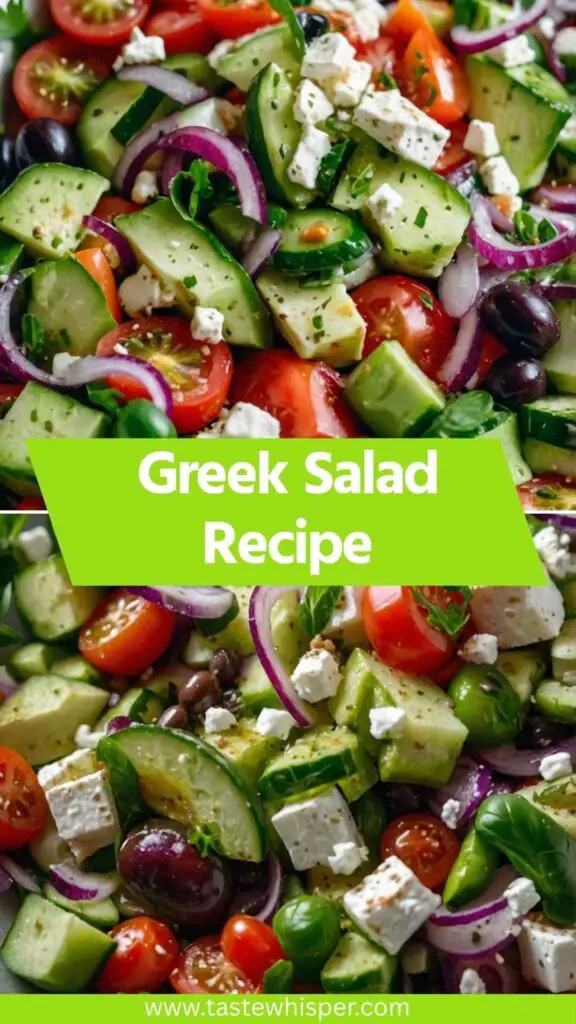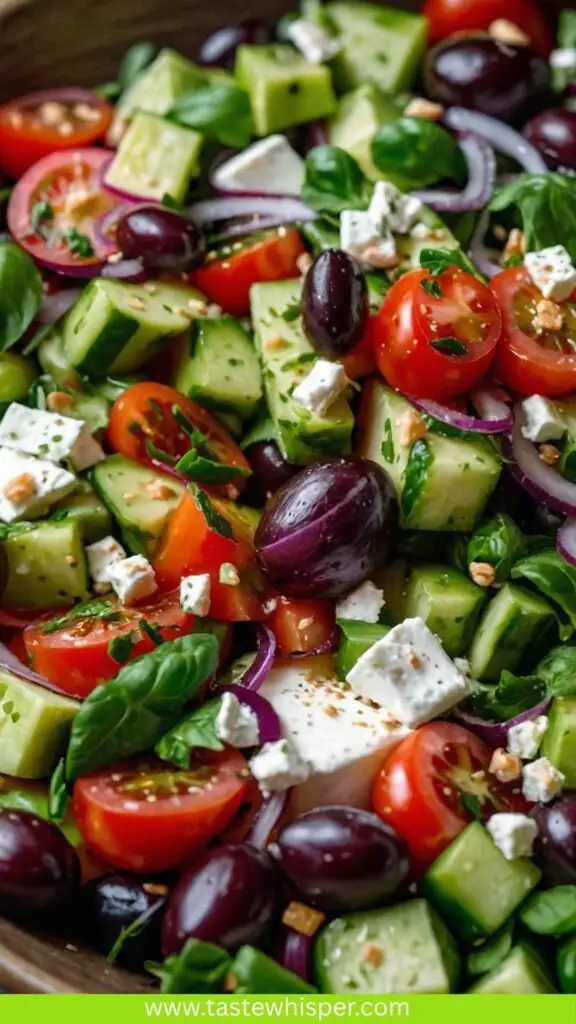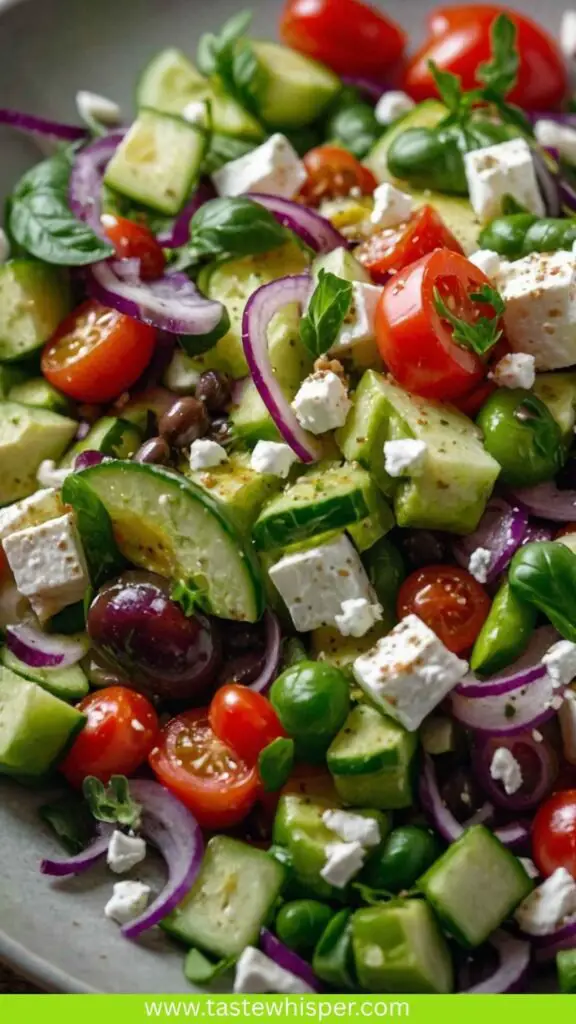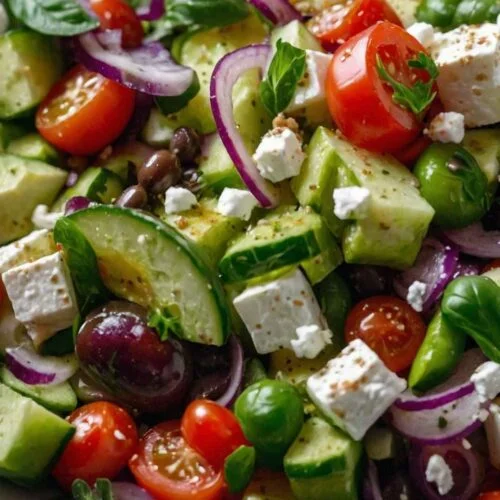As the sun blazes overhead and summer gatherings fill the air with laughter, a Greek salad often finds its special place on the table. Picture it: a vibrant mix of fresh vegetables, salty feta, and a drizzle of olive oil, all coming together to create a dish that’s not just tasty but also refreshing. But what pairs perfectly with this colorful salad?
Think grilled chicken skewers, crispy pita chips, or even a side of hummus. The options are endless! Whether it is a picnic at the park or a casual dinner, Greek salad enhances the entire experience. So, let’s dive deep into what makes this simple dish so inviting and how to whip it up right at home!

You’ll Also Like These Recipes
What is a Greek Salad Recipe?
A classic Greek salad is a medley of vegetables, fresh herbs, and tangy feta cheese, typically dressed with olive oil and vinegar. Originating from Greece, this dish celebrates simplicity and freshness. The traditional components may vary slightly by region, but the core remains consistent: cucumbers, tomatoes, olives, onions, and feta.
This dish is all about balance—sweetness from the tomatoes, the crunchiness of cucumbers, and the briny kick from olives. It’s a symphony of colors, textures, and flavors that together create a meal that resonates with simplicity and health.
What is the Flavor Profile of This Dish?
Imagine biting into a crisp cucumber that snaps under your teeth, followed by the sweetness of ripe tomatoes. The olives add a briny depth, while the feta introduces a creamy, tangy note that elevates everything. The dressing, typically made from extra virgin olive oil and red wine vinegar, ties all these elements together perfectly.
Generally speaking, you will find a refreshing zest from the lemon juice combined with aromatic herbs, such as oregano and dill. This unique flavor profile encapsulates the essence of Mediterranean cuisine—fresh, bold, and absolutely delightful.
What Makes This Recipe Different From Other Greek Salad Recipes?
While many Greek salad recipes follow a standard approach, this one emphasizes balance—the perfect ratio of vegetables to feta and dressing. The freshness of ingredients is prioritized, encouraging the use of garden-fresh produce.
Additionally, this version embraces the delightful crunch of veggies and includes a hint of garlic for that extra zing. Moreover, it provides flexibility for substitutions that accommodate different tastes, making it ideal for gatherings where dietary preferences vary.
Despite its simplicity, this Greek salad showcases depth and flavor that can surprise even the most discerning palates.
Ingredients You’ll Need
Let’s gather our materials for this vibrant dish. Here’s what you’ll need:
3/4 large cucumber, peeled, seeded, and coarsely chopped
3 large plum tomatoes, seeded and coarsely chopped
1 bell pepper, seeded and coarsely chopped
1/2 cup pitted black olives (preferably brine-cured), coarsely chopped
1/2 small red onion, chopped
Heaping 1/2 cup crumbled feta cheese
1/2 teaspoon chopped garlic
6 tablespoons extra virgin olive oil
2 tablespoons fresh lemon juice
1 teaspoon red wine vinegar
1/2 teaspoon dried oregano or 1 teaspoon chopped fresh oregano
1/2 teaspoon dried dill or 1 teaspoon chopped fresh dill
Salt and freshly ground black pepper, to taste
These fresh ingredients promise a salad bursting with flavors and textures.

Step-by-Step Directions
Step 1: Prep Your Ingredients
Start by washing all your vegetables thoroughly. Then, get chopping! Dice the cucumbers, tomatoes, and bell peppers into bite-sized pieces. The goal here is to have everything roughly the same size so that each forkful offers a little of everything.
Step 2: Mix the Vegetables
In a large bowl, combine the chopped cucumbers, tomatoes, bell peppers, olives, and red onion. Give them a gentle toss to mix everything together. Allow your colorful mixture to sit while you prepare the dressing.
Step 3: Make the Dressing
In a separate bowl, whisk together the olive oil, lemon juice, red wine vinegar, chopped garlic, oregano, dill, salt, and pepper. This dressing not only elevates the salad’s flavor but also adds an aromatic quality that is hard to resist.
Step 4: Combine Everything
Pour the dressing over the bowl of vegetables. Toss everything gently until every piece is lightly coated with the dressing. Be careful not to break the feta as you mix!
Step 5: Add the Feta
Now, it’s time for the final touch. Sprinkle the crumbled feta over the top, and give it one last gentle toss. This step adds a creamy texture and tanginess that complements the freshness of your salad beautifully.
Step 6: Chill and Serve
Let the salad sit for at least 15 minutes before serving. This resting period allows the flavors to mingle and develop. Serve it cold or at room temperature, and watch as everyone enjoys this delightful dish.
Tips On Making Greek Salad Recipe
Here are some pro tips to enhance your Greek salad-making experience:
Use Fresh Ingredients: Always opt for the freshest vegetables. The taste difference is significant.
Let It Rest: Allowing the salad to rest after mixing helps the flavors to meld beautifully.
Experiment with Additions: Feel free to add in cooked chickpeas or avocado for extra protein and creaminess.
Opt for Quality Olive Oil: The dressing makes a big impact, so choose a high-quality extra virgin olive oil.
Prepare in Advance: This salad can be made ahead of time. Just keep it covered in the refrigerator for up to 24 hours before serving.
Nutrition Information
A serving of this Greek salad (approximately 1 cup) contains roughly:
Calories: 180
Protein: 5g
Carbohydrates: 8g
Fiber: 2g
Sugars: 3g
Fat: 16g
Sodium: 350mg
This dish is low in calories but high in nutrients, making it a fantastic addition to any meal.
How Can I Store This Greek Salad Recipe?
Storing your Greek salad is simple. If you have leftovers, place them in an airtight container. They can last in the fridge for up to 3 days. However, keep in mind that the longer it sits, the more the vegetables will soften and release moisture. The salad is best enjoyed fresh, but it can still be tasty after a day or two. Just give it a good stir before serving!

Substitutes for Ingredients
In case you find yourself short on certain ingredients or looking to customize your salad, here are some great substitutes:
Cucumber: If fresh cucumbers aren’t available, zucchini works nicely. Use it raw for a similar crunch.
Olives: Don’t have black olives? Use green olives or even capers for a briny bite.
Onion: Red onion can be swapped for green onions or shallots for a milder flavor.
Feta Cheese: If you’re looking for a lower-sodium option, opt for goat cheese or cottage cheese for a different flavor profile.

Greek Salad
Equipment
- Bowl, Cup
Ingredients
- 3/4 large cucumber peeled, seeded, and coarsely chopped
- 3 large plum tomatoes seeded and coarsely chopped
- 1 bell pepper seeded and coarsely chopped
- 1/2 cup pitted black olives preferably brine-cured, coarsely chopped
- 1/2 small red onion chopped
- Heaping 1/2 cup crumbled feta cheese
- 1/2 teaspoon chopped garlic
- 6 tablespoons extra virgin olive oil
- 2 tablespoons fresh lemon juice
- 1 teaspoon red wine vinegar
- 1/2 teaspoon dried oregano or 1 teaspoon chopped fresh oregano
- 1/2 teaspoon dried dill or 1 teaspoon chopped fresh dill
- Salt and freshly ground black pepper to taste
Instructions
Step 1: Prep Your Ingredients
- Start by washing all your vegetables thoroughly. Then, get chopping! Dice the cucumbers, tomatoes, and bell peppers into bite-sized pieces. The goal here is to have everything roughly the same size so that each forkful offers a little of everything.
Step 2: Mix the Vegetables
- In a large bowl, combine the chopped cucumbers, tomatoes, bell peppers, olives, and red onion. Give them a gentle toss to mix everything together. Allow your colorful mixture to sit while you prepare the dressing.
Step 3: Make the Dressing
- In a separate bowl, whisk together the olive oil, lemon juice, red wine vinegar, chopped garlic, oregano, dill, salt, and pepper. This dressing not only elevates the salad’s flavor but also adds an aromatic quality that is hard to resist.
Step 4: Combine Everything
- Pour the dressing over the bowl of vegetables. Toss everything gently until every piece is lightly coated with the dressing. Be careful not to break the feta as you mix!
Step 5: Add the Feta
- Now, it’s time for the final touch. Sprinkle the crumbled feta over the top, and give it one last gentle toss. This step adds a creamy texture and tanginess that complements the freshness of your salad beautifully.
Step 6: Chill and Serve
- Let the salad sit for at least 15 minutes before serving. This resting period allows the flavors to mingle and develop. Serve it cold or at room temperature, and watch as everyone enjoys this delightful dish.
Notes
Let It Rest: Allowing the salad to rest after mixing helps the flavors to meld beautifully.
Experiment with Additions: Feel free to add in cooked chickpeas or avocado for extra protein and creaminess.
Opt for Quality Olive Oil: The dressing makes a big impact, so choose a high-quality extra virgin olive oil.
Prepare in Advance: This salad can be made ahead of time. Just keep it covered in the refrigerator for up to 24 hours before serving.
Nutrition
Frequently Asked Questions
1. Is Greek salad healthy?
Yes, Greek salad is packed with nutrients. It includes plenty of vegetables rich in vitamins, minerals, and fiber. The olive oil provides healthy fats, while feta cheese adds protein and calcium.
2. Can I make Greek salad vegan?
Certainly! You can simply omit the feta cheese or substitute it with a plant-based cheese option. Nutritional yeast is another fantastic option for a cheesy flavor without using dairy.
3. How is Greek salad traditionally served?
Greek salad is often served as a side dish alongside grilled meats or seafood, especially during summer gatherings. It can also be a light meal by itself, particularly if you add a protein source like chickpeas or grilled tofu.
4. What’s the best time to enjoy Greek salad?
While this dish is perfect for summer, its fresh ingredients make it refreshing year-round. It works wonderfully for picnics, cookouts, or as a light lunch option anytime.
5. How can I make Greek salad more filling?
To turn your salad into a complete meal, consider adding proteins like grilled chicken, shrimp, or chickpeas. Quinoa or farro can also add substance without overpowering the flavors.
Conclusion
Creating a classic Greek salad is not just about following a recipe; it’s about embracing a lifestyle that appreciates fresh, wholesome ingredients. The crunch of seasonal vegetables, the tangy feta, and the rich olive oil come together for a delicious experience.
Whether paired with grilled meats or enjoyed on its own, Greek salad brings joy and nourishment to every table. So go ahead, gather your ingredients, and embark on this culinary adventure that’s full of flavor and tradition. You won’t just be making a salad; you’ll be creating a dish that brings people together.


